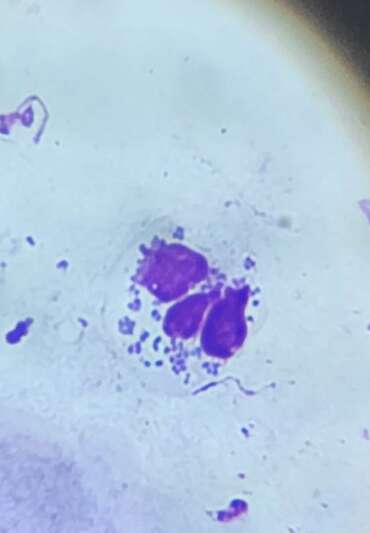In my years in private practice, most owners are surprised when we discover their cat has an ear infection. This is a more common problem than most people realize, and often has been going on for a long time before it is detected. Owners often feel awful that they did not notice, but cats can often hide signs until the severity of the problem becomes too much for them to mask. This is why regular visits with your veterinarian are so valuable.
Why are ear infections missed more in cats?
There is no one right answer to this question, but there are a number of possible reasons why. First, cats are often more resistant to invasive handling by owners, so it is not very common for owners to routinely restrain a cat to look in their ears. Second, cats as a species are more behaviorally independent, and as such tend to withdraw more and hide their illnesses when there is a problem as compared to dogs. Third, the ear canal of the cat does not seem to become inflamed as much as that of dogs, which probably helps them mask their signs even better.
What causes an ear infection in cats?
There are a lot of different causes from fungal to bacterial, to parasites (ear mites). Sometimes, it can be a one-off occurrence, like if moisture got trapped in the ear allowing yeast or bacteria to overgrow. Ear mites are contagious for other dogs and cats, so if there is exposure to an infected animal this can cause an infection. There are also causes that cause a breakdown of the normal barriers that prevent infection in the ear canal, leading to recurrent ear infections. Some examples of this include allergies (prolonged skin inflammation), anatomical changes such as masses in or narrowing of the ear canals or ear infections that are not fully cleared due to extension into the inner or middle ear canal.
What are the signs of an ear infection in cats?
While cats can show fewer signs than dogs, there are a few things to look out for. The first is discharge in the ear canal. Normal cat ear canals may have a mild amount of thin waxy/oily clear to light tan debris. If there is a significant amount of discharge, it could be a build-up of wax but it could also be a sign of an ear infection, especially if the discharge is thick or an abnormal color (e.g. white to green, dark brown, or black and gritty).
The second is behavior. If your cat is scratching its ears, shaking its head, or if they are really leaning into a massage of the base of the ear, these are likely signs that the ear canal is itchy. This can often indicate an ear infection or a condition that could lead to an ear infection, like allergies. If you have ever had an allergy attack, usually the ears and the back of the throat are very itchy. This also applies to your feline friend.
If your cat seems to be more sensitive about you touching their ears or the top of their head than usual, this could indicate ear pain, and if your cat is showing balance problems, tilting their head, or having unusual eye movements, these could all be signs that a deeper ear infection could be occurring.
Lastly, hair loss or wounds on the face or back of the neck could all indicate a cat has been sneaking some scratches when you are not looking. Remember they like to hide their problems. If there is obvious redness and swelling, there is a really good chance there is an infection, as it does tend to take a more severe infection to cause inflammation to the canal in cats than in dogs.
I think my cat has an ear infection, but I want to try over-the-counter treatment first. What options do I have?
Well, this depends on what is going on in the ear. I usually give my clients the chance to try cleaning the ears first, usually once a day for 3-5 days, then space it out to every 3 days or so for a few weeks. You can usually find ear cleaners safe for cats at pet stores, but be careful not to get sucked into all the marketing ploys: “Ours has Aloe vera”, “Ours is oatmeal based”, etc. Typically a standard ear cleaner is able to take care of any wax build-up issue unless it is severely impacted, in which case it needs veterinary attention.
I generally recommend against home remedies (e.g. apple cider vinegar, mineral oil, etc) for many reasons. First, some of the stuff out there can just be abrasive and painful and in some cases cause more harm than good. It can be a struggle to administer even appropriate ear therapy to cats. They learn the pattern and if we start by using an ineffective treatment, especially one that is potentially painful, that makes appropriate treatment all the more difficult.
Second, it is not really known how safe a lot of these “home remedies” are because they are not well tested, and evidence in their favor is usually anecdotal at best. For instance, if the ear drum is not intact, putting anything in the ear canal, especially untested products, can have the potential to cause damage to the cells and structures responsible for balance and hearing. In addition, there are more effective products that contain medications targeted toward the cause of infection depending on whether it is caused by bacteria, yeast, or mites.
Third, while there may be some effectiveness to some of the home remedies, there are a lot more effective targeted treatments. For instance, mineral oil may be able to smother ear mites in the ear canal, but mites can often be located on the top of the head and back of the neck as well. Any mites left alive can just re-colonize the ears in short order. Systemic mite treatment (e.g. Revolution) can kill mites inside and outside of the ears.
If I know my cat has an ear infection, how is a vet visit going to help me?
A vet visit is going to start with a physical exam. We have a special tool called an otoscope, that allows us to evaluate the ear canal for discharge, swelling, and masses and establish that the eardrum looks normal and is intact. It is not always possible to visualize the eardrum in awake animals especially if there is a large amount of discharge or the ear is very uncomfortable, but there are different treatment options if we know the eardrum has been damaged. Your veterinarian can perform a test called a cytology, where they take a sample from the ear, stain it, and look at it under the microscope. They can also check for ear mites. Knowing the cause of the ear infection can allow for more targeted treatment. If there are substantial bacteria present, your veterinarian may decide to add systemic antibiotics on top of topical therapy or recommend another test called a culture to identify the type of bacteria and what antibiotics will be effective. Additionally, veterinarians have legal obligations to maintain a valid veterinary-client-patient relationship in order to be able to dispense medications. A physical exam allows us to get the best idea for the type and severity of the problem, discuss what treatment options would be best for the patient and owner, and can even help us find other problems (e.g. allergies, ear canal masses, etc), which would prevent resolution of the issue with standard treatment. Chronic ear problems can be very frustrating and the sooner underlying issues can be addressed, the faster your cat can get back to feeling better.

Untreated ear infections can lead to pain (sometimes leading to aggression), loss of hearing, narrowing of the ear canal (making future resolution more difficult), balance issues, and self-trauma. If you think your cat has an ear infection, please call your veterinarian to at least discuss the issue and plan moving forward. Our cats cannot talk to us and in fact, they often mask their illness, so it is our responsibility as owners to advocate for their needs. As the owner, you know your pet best, so if something seems off, it is better to get it checked out.
Can Traditional Chinese Veterinary Medicine (TCVM) be used to treat ear infections in cats?
Western medicine is likely the quickest resolution for most simple ear infections, but especially in animals with chronic ear issues or in cases where owners are really trying to avoid medications, TCVM could offer useful approaches to try. There are acupuncture points that can be used for treating this condition. Food therapy could be used to help support underlying causes of diseases, like allergies. As always, results will all depend on the circumstances of each case, but we would be happy to discuss if this might work for you. Please feel free to contact us.

